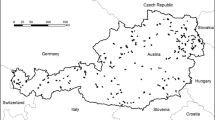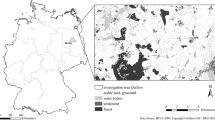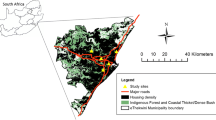Abstract
Landscape structure affects farmland bird species richness and diversity at different scales. We develop a predictive, metric-based model for farmland bird species richness in different bird guilds and study how the research area size influences the relationship between bird diversity and landscape metrics. Thirty research locations (randomly selected, each containing four counting points) were located in three counties of Estonia. In early summer 2002 and 2004, two bird counts per point were carried out in each research location. Three landscape metrics (patch density, edge density and Shannon’s diversity index) were calculated at three spatial scales: 100- and 200-m buffer zones around the count points and in a 1 km2 at 1 m × 1 m grain size. Using generalized additive mixed models with repeated measures, we found in most cases that the proportion of variance explained between the bird variables and landscape metrics increased with an increased study area thus demonstrating the effect of scale. Thus, a larger research area is recommended for landscape metrics. At large scales, however, all used landscape metrics were equally good predictors for bird species richness.


Similar content being viewed by others
References
Anon (2008) Estonian Rural Development Plan 2007–2013. Ministry of Agriculture, Tallinn
Barbaro L, Rossi J-P, Vetillard F, Nezan J, Jactel H (2007) The spatial distribution of birds and carabid beetles in pine plantation forests: the role of landscape composition and structure. J Biogeogr 34:644–652
Bennett AF, Radford JQ, Haslem A (2006) Properties of land mosaics: implications for nature conservation in agricultural environments. Biol Conserv 133:250–264
Bibby CJ, Burgess ND, Hill DA, Mustoe SH (1992) Bird census techniques. Academic Press, London
Böhning-Gaese K (1997) Determinants of avian species richness at different spatial scales. J Biogeogr 24:49–60
Donald PF, Green RE, Heath MF (2001) Agricultural intensification and the collapse of Europe’s farmland bird populations. Proc R Soc Lond Ser Biol Sci 268:25–29
Donald PF, Pisano G, Rayment MD, Pain DJ (2002) The common agricultural policy. EU enlargement and the conservation of Europe`s farmland birds. Agric Ecosyst Environ 89:167–182
Donald PF, Sanderson FJ, Burfield IJ, van Bommel FPJ (2006) Further evidence of continent-wide impacts of agricultural intensification on European farmland birds, 1990–2000. Agric Ecosyst Environ 116:189–196
Elts J, Kuresoo A, Leibak E, Leito A, Leivits A, Lilleleht V, Luigujõe L, Mägi E, Nellis R, Nellis R, Ots M (2009) Status and numbers of Estonian birds, 2003–2008. Hirundo 22:3–31
ESRI Inc (2002) ArcView version 3.1. ESRI, Inc., Redlands, CA
Heikkinen RK, Luoto M, Virkkala R, Rainio K (2004) Effects of habitat cover, landscape structure and spatial variables on the abundance of birds in an agricultural-forest mosaic. J Appl Ecol 41:824–835
Herzon I (2007) Ode to a Skylark: Agricultural intensification and farmland birds in the Baltic region. Phd Thesis, Department of Applied Biology. University of Helsinki
Herzon I, O’Hara RB (2007) Effects of landscape complexity on farmland birds in the Baltic States. Agric Ecosyst Environ 118:297–306
Kleijn D, Berendse F, Smit R, Gilissen N (2001) Agri-environment schemes do not effectively protect biodiversity in Dutch agricultural landscapes. Nature 413:723–725
Koskimies P, Väisänen RA (1991) Monitoring bird populations: a manual of methods applied in Finland. Finnish Museum of Natural History, Helsinki
Mander Ü, Kuusemets V, Hayakawa Y (2005) Purification processes, ecological functions, planning and design of riparian buffer zones in agricultural watersheds. Ecol Eng 24:421–432
Mayer AL, Cameron GN (2003a) Landscape characteristics, spatial extent, and breeding bird diversity in Ohio, USA. Divers Distrib 9:297–311
Mayer AL, Cameron GN (2003b) Consideration of grain and extent in landscape studies of terrestrial vertebrate ecology. Landsc Urban Plan 65:201–217
McGarigal K, McComb WC (1995) Relationship between landscape structure and breeding birds in the Oregon coast range. Ecol Monogr 65:235–260
McGarigal K, Cushman SA, Neel MC, Ene E (2002) FRAGSTATS: spatial pattern analysis program for categorical maps. Computer software program produced by the authors at the University of Massachusetts, Amherst. Available at the following web site: http://www.umass.edu/landeco/research/fragstats/fragstats.html
Morris AJ, Whittingham MJ, Bradbury RB, Wilson JD, Kyrkos A, Buckingham DL, Evans AD (2001) Foraging habitat selection by yellowhammers (Emberiza citrinella) nesting in agriculturally contrasting regions in lowland England. Biol Conserv 101:197–210
Newton I (2004) The recent declines of farmland bird populations in Britain: an appraisal of causal factors and conservation actions. Ibis 146:579–800
O’Connor J, Shrubb M (1986) Farming and birds. Cambridge University Press, Cambridge
Pain D, Pienkowski M (1997) Farming and birds in Europe. The common agricultural policy and its implications for bird conservation. Academic Press, London
Piha M, Pakkala T, Tiainen J (2003) Habitat preferences of the Skylark Alauda arvensis in southern Finland. Ornis Fennica 80:97–110
Piha M, Tiainen J, Holopainen J, Vepsäläinen V (2007) Effects of land–use and landscape characteristics on avian diversity and abundance in a boreal agricultural landscape with organic and conventional farms. Biol Conserv 140:50–61
Pinheiro J, Bates D, DebRoy S, Sarkar D, the R Core team (2011) Package ‘nlme’ May 6, 2011. (http://cran.r-project.org/web/packages/nlme/nlme.pdf)
Prins E, Petersen BS, Auninš A, Priednieks J (2005) Using Landsat TM and field data to produce maps of predicted bird densities in Latvian farmland. Int J Remote Sens 26:1881–1891
R Development Core Team (2010) R: a language and environment for statistical computing. R Foundation for Statistical Computing, Vienna, Austria. ISBN 3-900051-07-0, URL http://www.R-project.org/
Robinson RJ, Sutherland WJ (2002) Post war changes in arable farming and biodiversity in Great Britain. J Appl Ecol 39:157–176
Schifferli L (2001) Birds breeding in a changing farmland. Acta Ornithol 36:37–51
Schifferli L, Fuller RJ, Muller M (1999) Distribution and habitat use of bird species breeding on Swiss farmland in relation to agricultural intensification. Wogelwelt 120:151–161
Tiainen J, Pakkala T (2001) Birds. In: Pitkänen M, Tiainen J (eds) Biodiversity of agricultural landscapes in Finland. BirdLife Finland Conservation Series (No 3), Helsinki
Uuemaa E, Mander Ü, Marja R (2013) Trends in the use of landscape spatial metrics as landscape indicators: a review. Ecol Indic. doi:10.1016/j.ecolind.2012.07.018
Vepsäläinen V, Tiainen J, Holopainen J, Piha M, Seimola T (2010) Improvements in the Finnish agri-environment scheme are needed in order to support rich farmland avifauna. Ann Zool Fenn 47:287–305
Virkkala R, Luoto M, Rainio K (2004) Effects of landscape composition on farmland and red-listed birds in boreal agricultural-forest mosaics. Ecography 27:273–284
Wood S (2011) Package ‘mgcv’April 14, 2011. (http://cran.rproject.org/web/packages/mgcv/mgcv.pdf)
Wu JG, Shen WJ, Sun WZ, Tueller PT (2002) Empirical patterns of the effects of changing scale on landscape metrics. Landsc Ecol 17:761–782
Zuur AF, Ieno EN, Walker NJ, Saveliev AA, Smith GM (2009) Mixed effects models and extensions in ecology with R. Springer, New York
Acknowledgments
This study was supported by Target Funding Project No. SF0180127s08 of the Ministry of Education and Science of Estonia. We are also thankful to Dr. Irina Herzon who began the farmland bird project in Estonia, Dr. Märt Möls for statistical support and Uku Paal for help with the fieldwork and Alexander Harding and David Pelly for language correction.
Author information
Authors and Affiliations
Corresponding author
Electronic supplementary material
Below is the link to the electronic supplementary material.
Rights and permissions
About this article
Cite this article
Marja, R., Uuemaa, E., Mander, Ü. et al. Landscape pattern and census area as determinants of the diversity of farmland avifauna in Estonia. Reg Environ Change 13, 1013–1020 (2013). https://doi.org/10.1007/s10113-013-0409-7
Received:
Accepted:
Published:
Issue Date:
DOI: https://doi.org/10.1007/s10113-013-0409-7




